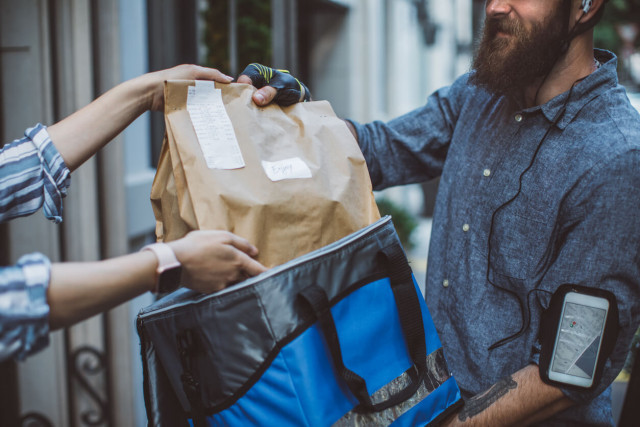As restaurants struggle to stay in business and dining rooms across the country close due to COVID-19, food delivery apps—like Uber Eats, Grubhub, DoorDash, or Just Eat—have picked up steam.
Before the global pandemic took hold of the food and beverage industry earlier this year, food delivery services were already growing rapidly at 14%, and sales were expected to hit $200 billion by 2025. “Delivery has provided a lifeline for some restaurants, increasing their reach significantly and opening them to markets that were mostly unattainable,” said JWU hospitality professor Brian Warrener. However, with mounting costs and greater competition, third-party delivery has proven to be a mixed bag for many restaurants—calling into question whether or not devoting resources to this service is in a restaurant’s best interest.
Changing Demands
According to Warrener, age and demographic largely influence whether or not a person is more likely to dine-in versus ordering delivery. “Younger consumers mostly prefer the nearly unlimited choices and convenience of food delivery over cooking at home or dining-in,” he said. “Older consumers, who are less tech-savvy and are accustomed to dining-in, are more likely to do so.”
Rising Competition
In addition to changing demands, the number of restaurants offering delivery—and the number of apps consumers can choose from— has gone up. In early- to mid-2019, consumers were surveyed by US Foods noting they had an average of two food delivery service apps downloaded. They used them a few times a month to specifically seek out a restaurant (54%) or browse for food inspiration (46%). The average user said they would pay around $8.50 in service fee, delivery fee, and tips combined. Because of the high likelihood of a person using a delivery app, Warrener said operators may have no choice but to get on board. “Millennials have become accustomed to accessing their food in this manner, and opting out of third-party delivery may leave restaurants isolated from this very important demographic.”
A Growing Option for Ghost Restaurant
One interesting option that some restaurants have explored is opening a ghost restaurant. A ghost restaurant is a virtual or online-only restaurant that is in a separate kitchen with a separate staff and no brick and mortar front. Customers order through the app. This process slashes overhead costs and allows food pricing to remain similar to their restaurants without overtaxing their kitchen or undercutting their revenue stream.
This provides companies the opportunity to test out concepts with less risk and keep rent low with smaller spaces. It provides a smaller financial risk for startups that want to join the foodservice industry. But many ghost restaurants have started and failed over the past few years because everything comes down to food quality. Food has to be well-priced, fast, fresh and consistent to make a good impression with customers. This can be a good option in a big city, but may not offer the same benefits in a city where delivery isn’t as common and overhead pricing isn’t as high.
Cost of Participation
However, participating with these delivery services is not always an affordable option for restaurants. Warrener, whose industry expertise revolves around food and beverage operations, tipping strategy, and responsible beverage service, says the fees restaurants pay to be part of delivery services are substantial. “Restaurants typically pay between 10 and 20% of sales generated for the privilege to be part of the service,” he explained, noting that some restaurants also pay more for enhanced services that might include special marketing and promotion.
In April, New York City saw a lawsuit that questioned the practice of third-party apps charging the same price for food while requiring restaurants to pay fees as high as 40% for their services to be offered. “These fees can be difficult to absorb for operations already working off of very thin margins,” Warrener explained. The NYC lawsuit led to a bill that required a 10% cap on fees, down from 12-40% previously charged. Cities, like Portland, have recently followed suit with rules capping fees applied to restaurants to 10%. Seattle, Philadelphia and Los Angeles all capped their limits at 15%.
All of these factors aside, food delivery services are likely here to stay. The convenience and support they offer many are services people value, but oversight is certainly needed. The question comes down to figuring out policies that work out fairly for the restaurants and deliverers impacted with each transaction. Customers will have a big say, since they will ultimately spend their dollar where they are treated well.
Are you interested in this topic? Considering a future in the industry? Give yourself a headstart with a bachelor’s degree in culinary arts & food service management from Johnson & Wales University. To learn more, complete the Request Info form, call 855-JWU-1881, or email [email protected].
